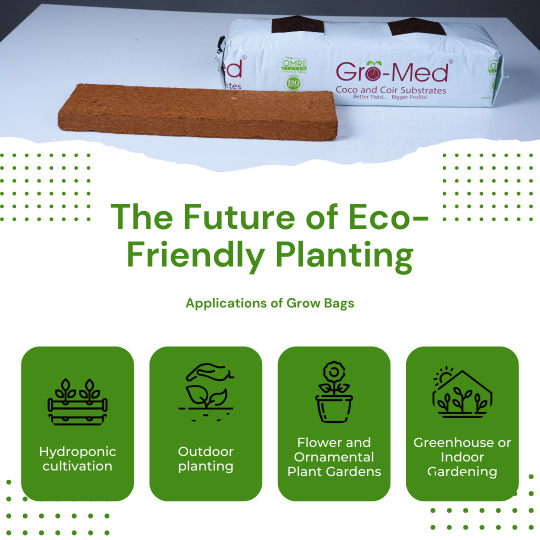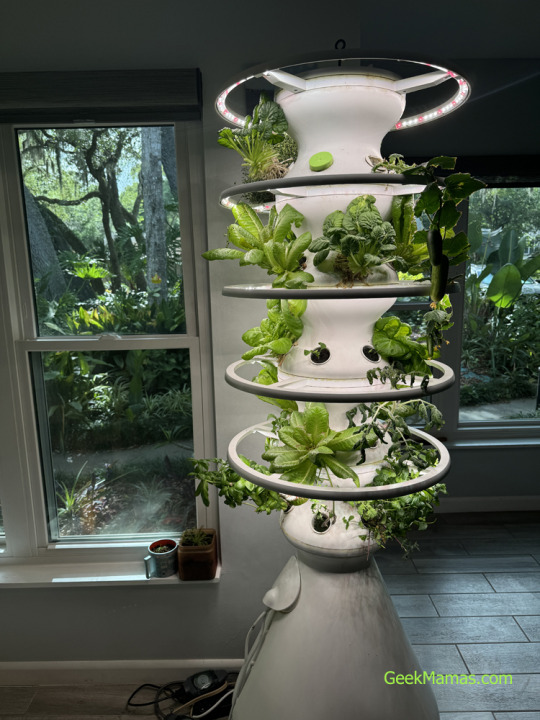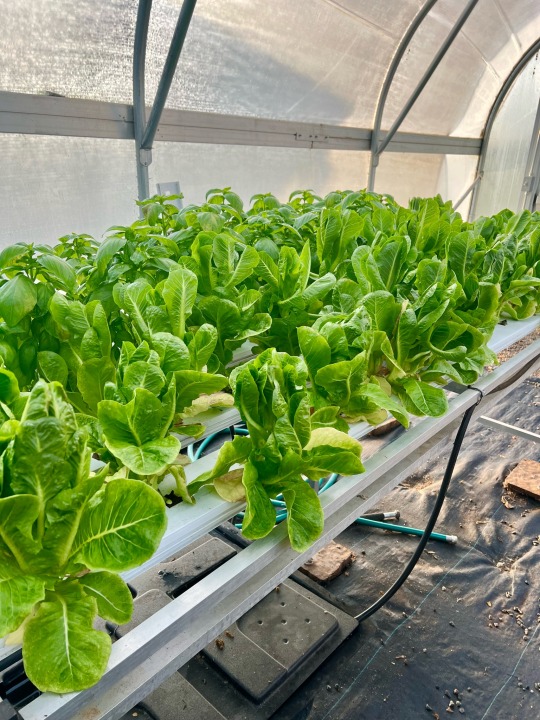#Hydroponic Gardening
Explore tagged Tumblr posts
Text

Maximize Your Garden's Potential with Coco Coir Grow Bags.
Coco Coir Grow Bags: Ideal for Healthy Plant Growth
Coco coir grow bags are an excellent choice for enhancing plant growth, offering superior aeration and irrigation capabilities. Made from a special blend of coco chips and coir pith, these grow bags provide the perfect air-to-water ratio for hydroponic systems, promoting healthy root development.
The grow bags are designed with customizable features, including plant holes, drip holes, and drainage holes, allowing farmers to tailor them to their specific needs. These holes ensure proper water flow and air circulation, creating an optimal growing environment for plants.
Planting and Drainage Features:
Plant Holes: Located on the upper surface of the grow bags, these holes are designed to accommodate the crops to be planted.
Drainage Holes: These are provided to prevent waterlogging by allowing excess irrigation water to drain freely.
Customization: The size, thickness, and weight of the grow bags can be adjusted based on the farmer’s requirements.
Coco coir grow bags are typically packed in high-density, UV-treated plastic bags to enhance durability. The medium has a neutral pH level of 5.5 to 7, which is ideal for nutrient release and encouraging vigorous plant growth.
UV Protection and Regional Customization:
In areas with high ultraviolet (UV) radiation, we offer grow bags with enhanced UV stability to ensure longevity and effectiveness.
For regions where UV radiation is minimal or not a concern, we recommend using cost-effective, UV-free bags (also known as "naked boards") for an affordable alternative.
Applications of Coco Coir Grow Bags
Coco coir grow bags are versatile and eco-friendly tools for a wide range of gardening and agricultural practices. Below are some of the key applications of these grow bags:
1. Hydroponic Gardening
2. Container Gardening
3. Seed Starting
Conclusion:
Coco coir grow bags offer a sustainable and highly effective solution for gardeners and farmers looking to enhance plant growth while promoting environmental responsibility. Their superior aeration, efficient water retention, and customizable features make them ideal for both hydroponic and traditional gardening setups. By providing the perfect balance of air and moisture, these grow bags foster healthy root systems and vigorous plant development. With options for UV-treated or UV-free bags tailored to different environmental conditions, coco coir grow bags are adaptable to a wide range of climates. Ultimately, they contribute to healthier plants, higher yields, and a more sustainable approach to modern agriculture.
2 notes
·
View notes
Text
What plants can be grown hydroponically?

In the world of modern agriculture, hydroponic gardening has emerged as a revolutionary method of cultivating plants without soil, using nutrient-rich water solutions. This innovative approach offers numerous advantages, including efficient resource utilization, faster growth rates, and the ability to grow crops in environments where traditional farming may not be feasible. Among the myriad of plants that can thrive in hydroponic systems, some stand out for their adaptability and productivity.
Leafy Greens: Lettuce, spinach, kale, and other leafy greens are some of the most popular choices for hydroponic cultivation. They have shallow root systems and high water requirements, making them perfectly suited for nutrient-rich water environments. With the right hydroponic setup, these greens can be grown year-round, providing a consistent supply of fresh produce.
Herbs: Basil, cilantro, mint, and parsley are excellent candidates for hydroponic growth. These aromatic herbs flourish in controlled hydroponic environments, offering superior flavor and quality compared to their soil-grown counterparts. Hydroponic herb gardens are ideal for culinary enthusiasts seeking a convenient and sustainable source of fresh herbs.
Tomatoes: Tomatoes are another popular choice for hydroponic cultivation. They thrive in nutrient-rich solutions and benefit from the support of trellises or vertical systems. Hydroponically grown tomatoes often exhibit enhanced flavor and texture, making them a favorite among home gardeners and commercial growers alike.
Cucumbers: Cucumbers are well-suited for best hydroponic systems, particularly when grown vertically to maximize space efficiency. With proper support structures and nutrient delivery, hydroponic cucumbers can produce abundant yields of crisp, flavorful fruits throughout the growing season.
Peppers: Bell peppers, chili peppers, and other varieties can thrive in hydroponic environments. These plants require consistent moisture and nutrient levels, which can be easily maintained in hydroponic systems. With proper care, hydroponically grown peppers can yield bountiful harvests of vibrant, flavorful fruits.
Strawberries: Hydroponic strawberry production has gained popularity in recent years due to its ability to maximize space and optimize growing conditions. By utilizing vertical towers or hanging systems, growers can cultivate strawberries without soil, leading to cleaner, healthier fruits and increased yields.
Microgreens: Microgreens are young, tender greens harvested at an early stage of growth. They are packed with nutrients and flavor, making them a popular choice for salads, sandwiches, and garnishes. Hydroponic systems offer an efficient means of producing high-quality microgreens year-round, providing chefs and home cooks with a continuous supply of fresh, nutritious greens.
Potatoes: While traditionally grown in soil, potatoes can also be cultivated hydroponically, especially in potato vertical farming systems. With proper tuber support and nutrient delivery, hydroponic potatoes can yield impressive harvests in a fraction of the space required for conventional soil cultivation. Vertical farming techniques optimize space utilization, making them ideal for urban agriculture and limited land environments.
When it comes to choosing the best hydroponics system for growing these plants, several factors should be considered, including available space, budget, and desired crop varieties. Vertical farming systems, such as tower gardens or vertical hydroponic racks, offer an efficient solution for maximizing space and increasing yields. These systems allow growers to stack multiple layers of plants vertically, optimizing space utilization and productivity.
Hydroponic gardening offers a versatile and sustainable approach to cultivating a wide range of plants, from leafy greens and herbs to tomatoes, cucumbers, and even potatoes. By harnessing the power of nutrient-rich water solutions and innovative growing techniques like vertical farming, growers can achieve impressive yields of high-quality produce year-round. Whether for commercial farming operations or home gardening enthusiasts, hydroponics represents a promising frontier in modern agriculture, paving the way for increased food security and environmental sustainability.
#hydroponic gardening#hydroponic plant growth#hydroponic syteam#hydroponic plant#hydroponics store near me#vertical hydroponic garden#hydroponic garden tower#hydroponic tower garden#hydroponic lettuce#hydroponic tomatoes#hydroponic seeds#hydroponics tower#aquaponics vs hydroponics#general hydroponics#hydroponic planter#hydroponic nutrients#hydroponic weed#hydroponics for weed#hydroponic strawberries#hydroponic fertilizer
3 notes
·
View notes
Text
Hydroponic Gardening for Beginners: Growing Beyond Soil
Introduction: In the ever-evolving world of gardening, hydroponics has emerged as a revolutionary method that challenges traditional soil-based cultivation. Whether you’re a seasoned gardener looking to expand your horizons or a complete beginner eager to embark on a green journey, hydroponic gardening offers a unique and efficient way to grow plants. In this guide, we’ll delve into the basics…

View On WordPress
3 notes
·
View notes
Text
How to Keep Gnats Away from Your Hydroponic Garden
#carnivorous plants#garden pests#Gardening#gardyn#gnats#hydroponic gardening#hydroponic plants#hydroponics#lettuce grow#pest control#plants
0 notes
Text
THEY'RE SPROUTING!!!


These are my two basil pods that I planted a couple of days ago
0 notes
Text
"i need to stop spending so much money on lunch" ➡ "maybe i could just buy some nice canned soups for easy lunches that don't make me sad" ➡ "why is canned soup so expensive" ➡ "i can just make some fucking soup" ➡ i don't actually feel like making soup ➡ i order a calzone ➡ "i need to stop spending so much money on lunch"
#original#THE ETERNAL CYCLE#in my defense a calzone from the local place is like eight bucks and lasts two days#anyway. i'm going to do it. i'm going to buy a big box of spaghettios for work.#i can start having salads again when the little hydroponic garden provides me with greenery
1K notes
·
View notes
Text
Coir Products for Indoor Gardening - Factorys Depot
Factory's Depot is the home of high-quality Coco Coir Products for Indoor Gardening, We sell coco coir products in bulk packs.

#factorysdepot#Coconut coir#Coco coir#Hydroponic Gardening#Coco peat gardening#coco peat#easy grow bag
0 notes
Text
How do we feel about the indoor hydroponic garden setups like Gardyn and Lettuce Grow? Are they worth the investment for people without yard space? Are the harvests enough to justify the cost of the plants?
People that have one/had one, what is your take on it?
0 notes
Text
Every once in a while I’ll see some posts about everyone should become vegan in order to help the environment. And that… sounds kinda rude. I’m sure they don’t mean to come off that way but like, humans are omnivores. Yes there are people who won’t have any animal products be it meat or otherwise either due to personal beliefs or because their body physically cannot handle it, and that’s okay! You don’t have to change your diet to include those products if you don’t want to or you physically can’t.
But there’s indigenous communities that hunt and farm animals sustainably and have been doing so for generations. And these animals are a primary source of food for them. Look to the bison of North America. The settlers nearly caused an extinction as a part of a genocide. Because once the Bison were gone it caused an even sharper decline of the indigenous population. Now thankfully Bison did not go extinct and are actively being shared with other groups across America.
Now if we look outside of indigenous communities we have people who are doing sustainable farming as well as hunting. We have hunting seasons for a reason, mostly because we killed a lot of the predators. As any hunter and they will tell you how bad the deer population can get. (Also America has this whole thing about bird feathers and bird hunting, like it was bad until they laid down some laws. People went absolutely nuts on having feathers be a part of fashion like holy cow.)
We’re slowly getting better with having gardens and vertical farms within cities, and there’s some laws on being able to have a chicken or two at your house or what-have-you in the city for some eggs. (Or maybe some quails since they’re smaller than chickens it’s something that you’d might have to check in your area.) Maybe you would be able to raise some honey bees or rent them out because each honey tastes different from different plants. But ultimately when it comes to meat or cheese? Go to your local farmers. Go to farmers markets, meet with the people there, become friends, go actively check out their farm. See how the animal lives are and if the farmer is willing, talk to them about sustainable agriculture. See what they can change if they’re willing. Support indigenous communities and buy their food and products, especially if you’re close enough that the food won’t spoil on its way to you. (Like imagine living in Texas and you want whale meat from Alaska and you buy it from an indigenous community. I would imagine that would be pretty hard to get.)
Either way everything dies in the end. Do we shame scavengers for eating corpses they found before it could rot and spread disease? Do we shame the animals that hunt other animals to survive? Yes factory farming should no longer exist. So let’s give the animals the best life we can give them. If there’s babies born that the farmer doesn’t want, give them away to someone who wants them as a pet. Or someone who wants to raise them for something else. Not everyone can raise animals for their meat. I know I can’t I would get to emotionally attached. I’d only be able to raise them for their eggs and milk.
Yeah this was pretty much thrown together, and I just wanted to say my thoughts and throw them into the void. If you have some examples of sustainable farming/agriculture, please share them because while I got some stuff I posted from YouTube, I’m still interested to see what stuff I might’ve missed!
#solarpunk#farming#hunting#agriculture#sustainability#sustainable farming#sustainable agriculture#like Rewilding farm land is pretty interesting and trying to replicate an ecosystem with farm animals but also allowing wild animals#to make homes in the rewild farm land is pretty cool#and I have an absolute love for food/garden forests#and hydroponics have shown to be really great for communities in the winter time and they want to have fresh produce#all sorts of cool stuff
943 notes
·
View notes
Text


"take one, leave one" welcome to the local plant exchange! 🌱💚
#dinchenix#pixel art#pixel#artists on tumblr#art#solarpunk#plantlove#hydroponics#greenhouse#urban gardening#retro aesthetic
369 notes
·
View notes
Text


Look at what happened with one of the hydroponic sunflowers!
37 notes
·
View notes
Text
Gardyn vs Lettuce Grow: Which Is Better?

View On WordPress
0 notes
Text











Caleb saw your 'Xavier is jealous of himself' and decided to raise 'Caleb is jealous of a tomato plant'.
#Ngl tho I love the idea that he'd build a hydroponic garden for mc#hey Caleb I need you to move out of starkhaven#I want a rose garden and an orchard#/kicked#love and deepspace#wonder plays#caleb#caleb xia#lads caleb#love and deepspace caleb#lnds caleb#lnds#lads
43 notes
·
View notes
Text

It's my 13 year anniversary on Tumblr 🥳
Well…I’m enjoying the ride.
#13 year tumblrversary#tumblr milestone#australia#hydroponics#food#aquaponics#vegetable garden#diy#backyard harvest#perth eze grow hydroponic and aquaponics#homegrown#youtube
13 notes
·
View notes
Text

My little indoor hydroponics setup is showing some signs of life!
I have 2 beefsteak toms, 2 cherry toms, and 2 jalapenos in my 6 pod Aerogarden.


In my knock-off 15 pod hydroponic garden, I have golden cherry toms and yellow plum toms peaking out. None of the other pods are growing yet, but no other pods have tomatoes. They are all peppers, and I am noticing that pepper plants take about 5 days longer to pop out their sprouts.

In some traditional dirt pots I have catnip, oregano, basil, and cilantro herbs going from seed.
I also have some pots of strawberry and pineberry going.
Next week, I'm going to pot plant some companion flowers like dandelion, daisy, sunflower, and marigolds.
Stay safe out there!
#beefsteak#growing tomatoes#urban gardening#gardeners on tumblr#container gardening#urban farming#green thumb#self sustainability#gardenblr#gardencore#growing stuff#cottagecore#tomato plant#mental health#hydroponic garden
11 notes
·
View notes
Text


9/19/23 ~ Hydroponics at school. Those cucumbers grew super fast 😳 and some Romaine Lettuce!
#indoor garden#container gardening#sustainable gardening#vegetable gardening#starting seeds#grow organic#grow your own food#organic gardening#tomato garden#green witch#greenhouse#greenhouse nursery#plant nursery#hydroponics#growing cucumbers#romaine lettuce#sustainable agriculture
68 notes
·
View notes